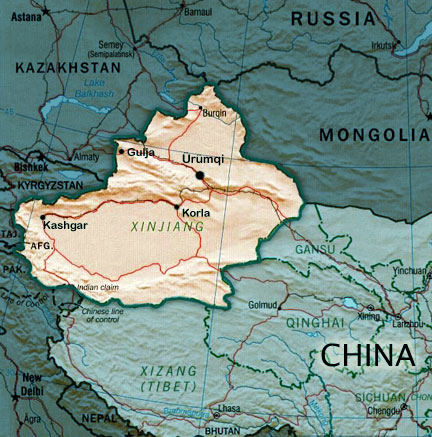
By Henry Srebrnik
Published on June 09, 2014
The Xinjiang Uighur Autonomous Region in the far west of the People’s Republic of China is more than 1.6 million square kilometres in area.
An arid region that historically was called East Turkestan, it is the homeland of the Uighurs, a Turkic Muslim people. In recent decades, though, Han Chinese moved in and took the better jobs and housing.
Today it is estimated that Uighurs make up only about 45 per cent of its 22 million people. Most of Xinjiang's Uighurs live in the southwestern portion of the region, in the Tarim Basin.
The influx of Chinese settlers has sparked resentment and calls for an independent Uighur state. But the Uighur struggle to assert a right to national self-determination is a difficult one. Unlike most formerly colonized peoples around the world, the Uighurs have never benefited from the fruits of de-colonization, since they were absorbed by a non-western neighbouring state, China.
Beijing refuses to acknowledge that it acts as a colonial power in the region; after all, it considers itself as having also been historically a victim of imperialism.
A Uighur Empire stretched from the Caspian Sea to Manchuria from 745 to 840, but it fragmented into smaller kingdoms and eventually came under Mongol control. Originally Buddhists, the Uighurs were converted to Islam by the beginning of the 16th century.
Xinjiang was conquered by the Qing (Manchu) dynasty in the mid-18th century and the Uighurs became subjects of the Chinese emperors.
Since then, there have been periodic uprisings against Chinese domination. In 1933 and 1944, the Uighurs temporarily gained their independence from Nationalist China, backed by the Soviet Union. The second East Turkistan Republic lasted from 1944 to 1949.
In 1949, the Chinese Communists took over the territory and declared it a Chinese province. In October 1955, Xinjiang was classified as an autonomous region.
There are ideological divisions among the Uighur nationalists. Some Uighurs call for an Islamic state, while others support a more ethnically independent and self-governing East Turkestan.
In July 2009, ethnic tension between the Han Chinese and Uighurs led to severe riots in the capital city of Urumqi. According to Chinese state media, almost 200 people were killed, and more than 800 injured.
There has been an upsurge in violence since then. In June 2012, six ethnic Uighur men tried to hijack an aircraft heading to Urumqi, but failed after passengers and crew resisted and restrained the hijackers. A year later, 27 people were killed in disturbances in the township of Lukqun; 17 of them were killed by rioters, while the other 10 were alleged assailants who were shot dead by police.
At least 29 people were killed in early March in an attack at a railway station in the Chinese city of Kunming, the capital of Yunnan province. It was an organized, premeditated assault by knife-wielding Uighur assailants, according to the Chinese Xinhua news agency.
In late May, attackers in two cars ploughed through shoppers while setting off explosives at a busy street market in Urumqi, killing 39 people. The Xinjiang regional government, which is Chinese-controlled, said in a statement that it was “a serious violent terrorist incident of a particularly vile nature.”
In response, China’s president Xi Jinping has called for moving more Uighurs to inland areas of China in order “to enhance mutual understanding among different ethnic groups and boost ties between them.”
All told, at least 180 people have been killed in attacks across China over the past year. But the anti-colonial goals that motivate Uighur nationalists to work to construct a modern Uighur nation remain unfulfilled. The plight of the Uighurs should command more attention.
Henry Srebrnik is a professor of political science at the University of Prince Edward Island.
